See the location on Chiang Mai Boutique Hotel Google Map
Amata Lanna อมตะล้านนา From 3500 to 4500 Baht. 222/2 Chareanprated Rd. Guests love to hotel, as you can read on tripadvisor.com
![]() Picture Amatalanna.com
Picture Amatalanna.com
![]() Picture Amatalanna.com
Picture Amatalanna.com
At Niman Conceptual Home แอทนิมมาน From 4400 to 6500 Baht. 37 Nimanhaemin Road.Eight rooms with decor that combines the arts of Burma, Nepal, India, Tibet and China, writes Concierge.com. The rooms are themed after goddesses. The hotel has been designed by Rachen Inthawong. He Says he used the location of a guide: "I felt Doi Suthep reflected the end of the eastern Himalayas. So I decorated At-Niman with a Himalayan feel", he told The Nation. Guests are excited, according to reviews on tripadvisor.com
![]()
a href="http://www.btlboutiquehotel.com/">Baan Thong Luang บ้านทองหลวง: From 2900 to 5900 Baht. 236/10 Wualai Rd. 18 differently styled and designed rooms decorated with Lanna antiques, staff dressedd in traditional Lanna costumes. Lush tropical garden.
![]()
Banthai Village บ้านไทย วิลเลจ: From 6000 to 14000 Baht. 19 Tapae Soi 3, Tapae Rd. Good reviews on tripadvisor.com. And detailed description by the Blog Life in Thailand.
![]() Picture Banthai Village
Picture Banthai Village
![]() Picture Banthai Village
Picture Banthai Village
Bann Tazala Boutique Hotel บ้านท่าศาลา: 8500 to 13500 Baht. 55/5 Moo 1 Sankampaeng Road. Five kilometres outside of the town. Design in Lanna style with Chinese furnishing. "Honeymoon heaven", ist the comment of one of many good reviews on tripadvisor.com. See pretty pictures and read about the French restaurant.
![]() Picture banntazala.com
Picture banntazala.com
![]() Picture banntazala.com
Picture banntazala.com
Bodhi Serene Hotel: From 6500 to 18000 Baht. 110 Ratchaphakhinai Road. The hotel is very close to homes of local people. "You can see your neighbors even their living rooms and private quarters while you are walking to your room with laundries hanging from windows as welcoming flags", writes one guest on tripadvisor.com and complains about the concert of the frogs during the night. But most of the reviews are good. See video.
![]()
Bupatara House: From 700 to 1100 Baht. 12/1 Soi 4 kor, Phra Pok Klao Road. 21 rooms. See video. You find a review on the blog of Evan Roberts.
![]() Picture Bupatara
Picture Bupatara
Buri Gallery House บุรี แกลเลอรี่ เฮาส์:From 950 to 2000 Baht. 102 Rachadamnoen Road. 20 rooms with the style of Thai-Lanna houses in a two-storey wooden building. You'll find the finest Lanna handicrafts in every part of the room. Located in the middle of the old city of Chiang Mai, near Wat Phra Singh. Read review on tripadvisor.com
![]() Picture Buri Gallery House
Picture Buri Gallery House
![]() Picture Buri Gallery House
Picture Buri Gallery House
Duang Champa Boutique Hotel ดวงจำปา - Hidden Gem: 2400 to 3800 Baht. 82 Ratchadamnoen Road. A building with ten rooms, every room different, in colonial style and a wooden house with two rooms. See a photoalbum by Fussy the Cat. Guests love it according to tripadvisor.com
![]() Picture marhas1
Picture marhas1
![]() Picture marhas1
Picture marhas1
The lobby
Eurana Boutique Hotel ยูรานา บูติค: 1800 Baht. 7/1 Moon Muang Road Soi 7. With swimmingpool. Good reviews on tripadvisor.com. See picture by arion».
Puripunn Baby Grand Boutique Hotel ปุรีปัน: From 7200 to 22 000 BAht. 104/1 Charoen Muang Soi 2,Charoen Muang Rd. 30 rooms. The hotel has excellent reviews on tripadvisor.com
![]() Picture Puripunn
Picture Puripunn
![]() Picture Puripunn
Picture Puripunn
Suite
![]() Picture Puripunn
Picture Puripunn
Baby Suite
RarinJinda Wellness Spa Resort: From 6500 zo 30 000 Baht. The Wellness Spa has an indoor heated hydrotherapy pool, an outdoor swimming Pool, fitness center, Yoga & Aerobics studio, hydrotherapy tub, Vichy dhower, fnfrared sauna, herbal rainforest steam sauna and a whirlpool with Chromo therapy. Thai Massage is housed Housed in a 140 year old antique Thai teak wood home. Good reviews on tripadvisor.com.
![]() Picture Rarinjinda
Picture Rarinjinda
![]() Picture Rarinjinda
Picture Rarinjinda
![]() Picture Rarinjinda
Picture Rarinjinda
Ruen Come In: From 3300 Bath. 79/3 Sirithron Road. Three suites and two deluxe rooms in a golden teak wood house. With a restaurant, where the familiy cooks dishes in Northern style after old recipes, see here. Ruen Come In is a hidden gem according to the excellent reviews on tripadvisor.com. It lies in a certain distance from the old town.
![]() Picture Ruen Come In
Picture Ruen Come In
Sirilanna Boutique Hotel: From 6000 Bath. 89/3 Ratchapakinai Road. Execellent hotel with pool according to the reviews on tripadvisor.com
![]() Picture Sirilanna
Picture Sirilanna
Deluxe room
Smile House Boutique From 700 to 1200 Baht. 3/5 Suriyawong Road, Soi 1. It's surrounded by the silversmith and lacquerware community on Wua Lai stree. See video.
![]() Picture Smile House Boutique
Picture Smile House Boutique
![]() Picture Smile House Boutique
Picture Smile House Boutique
Sri Tara Boutique Hotel ศรีธารา: From 6000 to 12000 Baht. 351/1 Charoen Prathet Road.
![]()
Tea Vana ทีวาน่า: From 3300 to 15000 Baht. 75 Lamphun Road. Decorated in modern Chinese style. See pictures on flickr.com. Serves and sells various kinds of tea and tea theme is also reflected by its design. Quite good reviews on tripadvisor.com. Read also review of professionaltravelguide.com
![]() Picture Tea Vana
Picture Tea Vana
Tri Yaan Na Ros Colonial House ตรีญาณรส โคโลเนียล เฮ้าส์ 3500 Baht. 156 Wualai Road. The building's character combines influences of Chinese housing, the lifestyle of the native Lanna people and continental architecture. "The courtyard was so relaxing and mystical", writes one guest of many excellent reviews on tripadvisor.com
![]() Picture by Long distance Clara.
Picture by Long distance Clara.
See gallery by eoconn and more pictures on pantip.com
Yaang Come Village: From 4900. 90/3 Sridonchai Road. Very good reviews on tripadvisor.com, that point to the quiet location close to the Night Market. Co-owners Khun Chitapong Kuawong and Khun Varee Kuawong have created a hotel in the style of a village of the Tai Lue people of Xishuangbanna, in China's Yunan Province. Read more at chiangmai-chiangrai.com.
![]() Picture leozaza
Picture leozaza
![]() Picture leozaza
Picture leozaza
Yantarasiri Boutique Resort ยันตรศิริ บูติค รีสอร์ท From 7000 to 18000 Baht. 24/17 Nimmanhaemin Road Soi 6. Some rooms with luxurious spa baths, all with Lanna décor in earth and forest colour tones. A macro-biotic restaurant serves Thai, Chinese and international cuisine. See video
![]() Picture Yantarasiri
Picture Yantarasiri
![]() Picture Yantarasiri
Picture Yantarasiri
![]() Picture Yantarasiri
Picture Yantarasiri
Zensala Resort: From 4500 Bath. 168 Patan Road. All rooms with floor to ceiling windows with view on Mae Ping River. With Zensala Spa, already known from Bangkok. Swimming pool and library. "Everything is tranquil and relaxing at this small resort, whose idyllic location offers just the right mix of privacy and easy access to the city", writes nationmultimedia.com. Very good reviews on tripadvisor.com for this new resort.
More places to stay in Chiang Mai:
Chiang Mai Guesthouses
Chiang Mai Hotels
Resorts outside of Chiang Mai:
Hotels and Resorts in Mae Rim แม่ริม: Holidays next to the ricefields and in the hills
Discover more:
Your Guide to Chiang Mai
Recommend this blog on Twitter and Facebook:
Amata Lanna อมตะล้านนา From 3500 to 4500 Baht. 222/2 Chareanprated Rd. Guests love to hotel, as you can read on tripadvisor.com
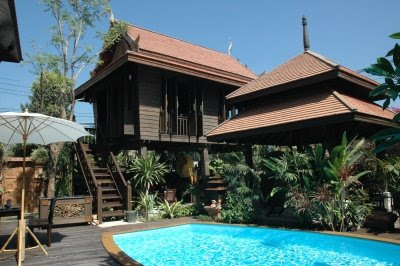 Picture Amatalanna.com
Picture Amatalanna.com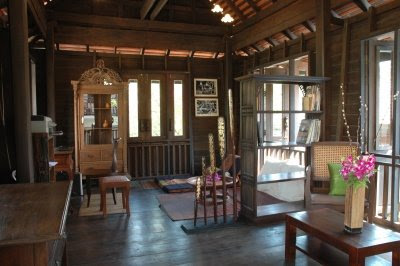 Picture Amatalanna.com
Picture Amatalanna.comAt Niman Conceptual Home แอทนิมมาน From 4400 to 6500 Baht. 37 Nimanhaemin Road.Eight rooms with decor that combines the arts of Burma, Nepal, India, Tibet and China, writes Concierge.com. The rooms are themed after goddesses. The hotel has been designed by Rachen Inthawong. He Says he used the location of a guide: "I felt Doi Suthep reflected the end of the eastern Himalayas. So I decorated At-Niman with a Himalayan feel", he told The Nation. Guests are excited, according to reviews on tripadvisor.com

a href="http://www.btlboutiquehotel.com/">Baan Thong Luang บ้านทองหลวง: From 2900 to 5900 Baht. 236/10 Wualai Rd. 18 differently styled and designed rooms decorated with Lanna antiques, staff dressedd in traditional Lanna costumes. Lush tropical garden.
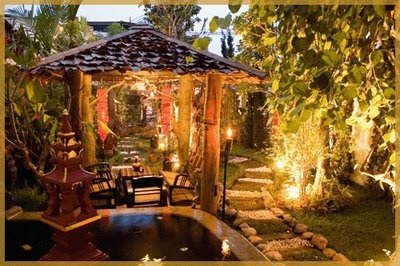
Banthai Village บ้านไทย วิลเลจ: From 6000 to 14000 Baht. 19 Tapae Soi 3, Tapae Rd. Good reviews on tripadvisor.com. And detailed description by the Blog Life in Thailand.
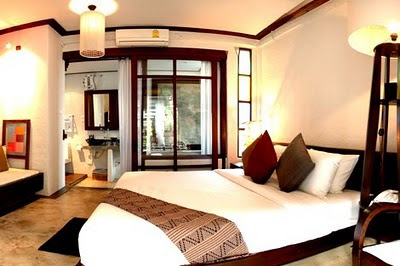 Picture Banthai Village
Picture Banthai VillageBann Tazala Boutique Hotel บ้านท่าศาลา: 8500 to 13500 Baht. 55/5 Moo 1 Sankampaeng Road. Five kilometres outside of the town. Design in Lanna style with Chinese furnishing. "Honeymoon heaven", ist the comment of one of many good reviews on tripadvisor.com. See pretty pictures and read about the French restaurant.
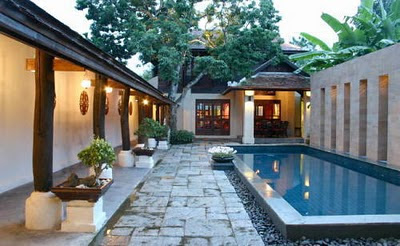 Picture banntazala.com
Picture banntazala.com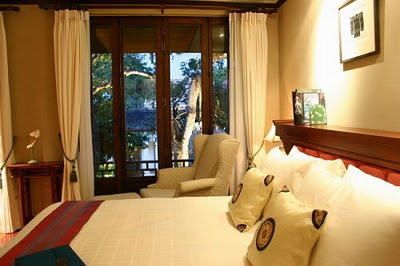 Picture banntazala.com
Picture banntazala.comBodhi Serene Hotel: From 6500 to 18000 Baht. 110 Ratchaphakhinai Road. The hotel is very close to homes of local people. "You can see your neighbors even their living rooms and private quarters while you are walking to your room with laundries hanging from windows as welcoming flags", writes one guest on tripadvisor.com and complains about the concert of the frogs during the night. But most of the reviews are good. See video.
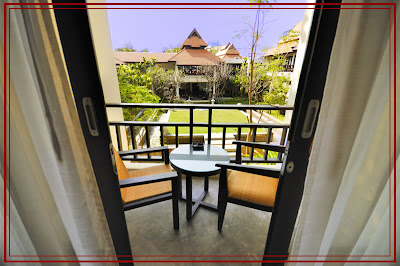
Bupatara House: From 700 to 1100 Baht. 12/1 Soi 4 kor, Phra Pok Klao Road. 21 rooms. See video. You find a review on the blog of Evan Roberts.
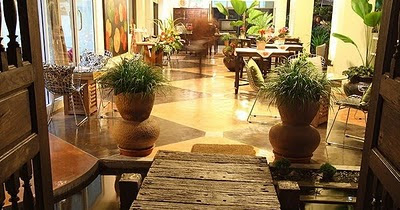 Picture Bupatara
Picture BupataraBuri Gallery House บุรี แกลเลอรี่ เฮาส์:From 950 to 2000 Baht. 102 Rachadamnoen Road. 20 rooms with the style of Thai-Lanna houses in a two-storey wooden building. You'll find the finest Lanna handicrafts in every part of the room. Located in the middle of the old city of Chiang Mai, near Wat Phra Singh. Read review on tripadvisor.com
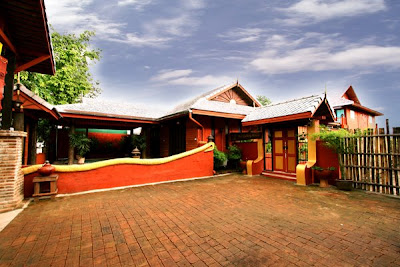 Picture Buri Gallery House
Picture Buri Gallery House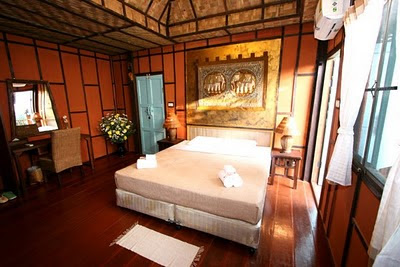 Picture Buri Gallery House
Picture Buri Gallery HouseDuang Champa Boutique Hotel ดวงจำปา - Hidden Gem: 2400 to 3800 Baht. 82 Ratchadamnoen Road. A building with ten rooms, every room different, in colonial style and a wooden house with two rooms. See a photoalbum by Fussy the Cat. Guests love it according to tripadvisor.com
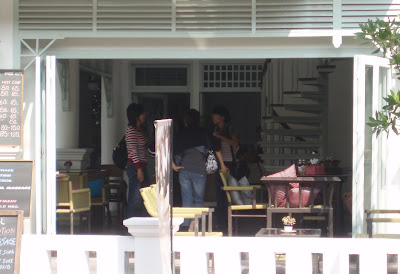 Picture marhas1
Picture marhas1The lobby
Eurana Boutique Hotel ยูรานา บูติค: 1800 Baht. 7/1 Moon Muang Road Soi 7. With swimmingpool. Good reviews on tripadvisor.com. See picture by arion».
Puripunn Baby Grand Boutique Hotel ปุรีปัน: From 7200 to 22 000 BAht. 104/1 Charoen Muang Soi 2,Charoen Muang Rd. 30 rooms. The hotel has excellent reviews on tripadvisor.com
 Picture Puripunn
Picture Puripunn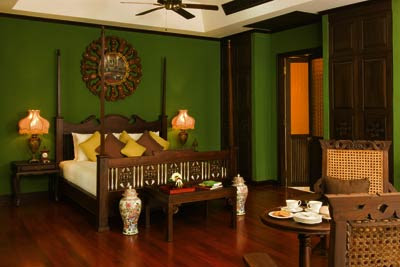 Picture Puripunn
Picture PuripunnSuite
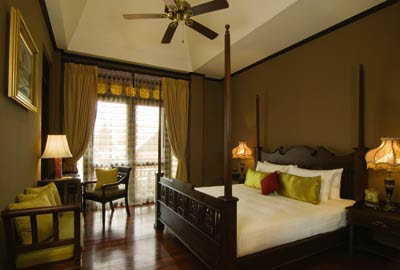 Picture Puripunn
Picture PuripunnBaby Suite
RarinJinda Wellness Spa Resort: From 6500 zo 30 000 Baht. The Wellness Spa has an indoor heated hydrotherapy pool, an outdoor swimming Pool, fitness center, Yoga & Aerobics studio, hydrotherapy tub, Vichy dhower, fnfrared sauna, herbal rainforest steam sauna and a whirlpool with Chromo therapy. Thai Massage is housed Housed in a 140 year old antique Thai teak wood home. Good reviews on tripadvisor.com.
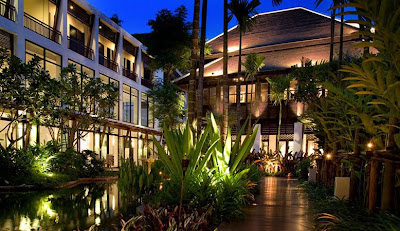 Picture Rarinjinda
Picture Rarinjinda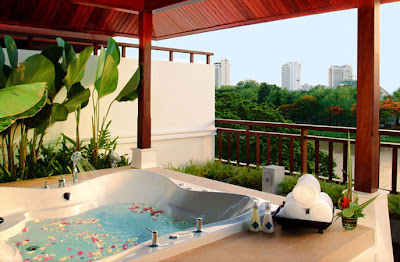 Picture Rarinjinda
Picture Rarinjinda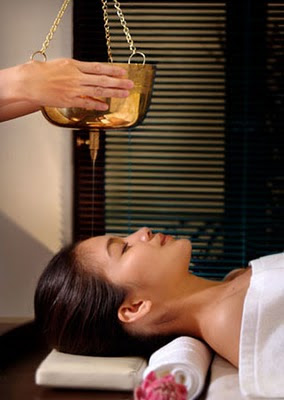 Picture Rarinjinda
Picture RarinjindaRuen Come In: From 3300 Bath. 79/3 Sirithron Road. Three suites and two deluxe rooms in a golden teak wood house. With a restaurant, where the familiy cooks dishes in Northern style after old recipes, see here. Ruen Come In is a hidden gem according to the excellent reviews on tripadvisor.com. It lies in a certain distance from the old town.
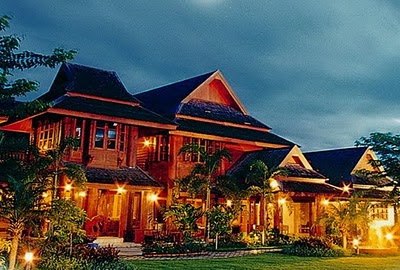 Picture Ruen Come In
Picture Ruen Come InSirilanna Boutique Hotel: From 6000 Bath. 89/3 Ratchapakinai Road. Execellent hotel with pool according to the reviews on tripadvisor.com
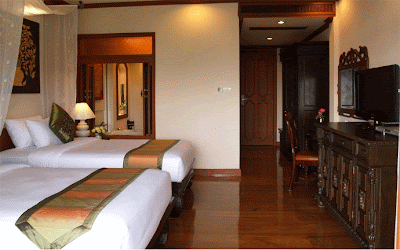 Picture Sirilanna
Picture SirilannaDeluxe room
Smile House Boutique From 700 to 1200 Baht. 3/5 Suriyawong Road, Soi 1. It's surrounded by the silversmith and lacquerware community on Wua Lai stree. See video.
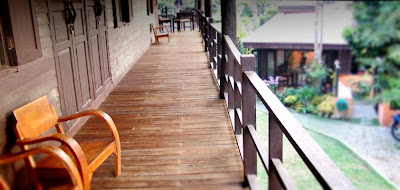 Picture Smile House Boutique
Picture Smile House Boutique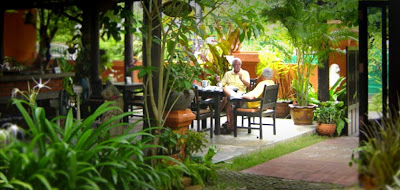 Picture Smile House Boutique
Picture Smile House BoutiqueSri Tara Boutique Hotel ศรีธารา: From 6000 to 12000 Baht. 351/1 Charoen Prathet Road.
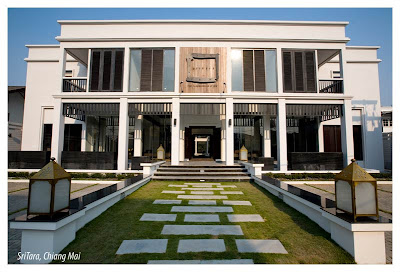
Tea Vana ทีวาน่า: From 3300 to 15000 Baht. 75 Lamphun Road. Decorated in modern Chinese style. See pictures on flickr.com. Serves and sells various kinds of tea and tea theme is also reflected by its design. Quite good reviews on tripadvisor.com. Read also review of professionaltravelguide.com
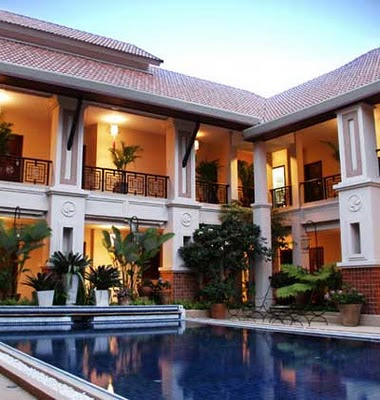 Picture Tea Vana
Picture Tea VanaTri Yaan Na Ros Colonial House ตรีญาณรส โคโลเนียล เฮ้าส์ 3500 Baht. 156 Wualai Road. The building's character combines influences of Chinese housing, the lifestyle of the native Lanna people and continental architecture. "The courtyard was so relaxing and mystical", writes one guest of many excellent reviews on tripadvisor.com
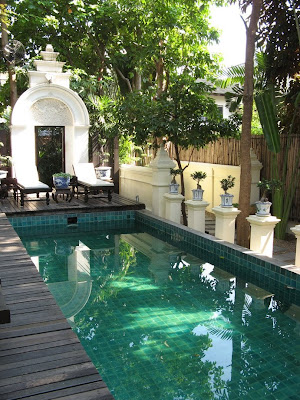 Picture by Long distance Clara.
Picture by Long distance Clara.See gallery by eoconn and more pictures on pantip.com
Yaang Come Village: From 4900. 90/3 Sridonchai Road. Very good reviews on tripadvisor.com, that point to the quiet location close to the Night Market. Co-owners Khun Chitapong Kuawong and Khun Varee Kuawong have created a hotel in the style of a village of the Tai Lue people of Xishuangbanna, in China's Yunan Province. Read more at chiangmai-chiangrai.com.
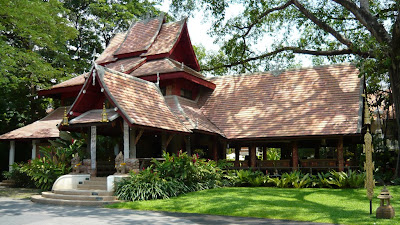 Picture leozaza
Picture leozaza Picture leozaza
Picture leozazaYantarasiri Boutique Resort ยันตรศิริ บูติค รีสอร์ท From 7000 to 18000 Baht. 24/17 Nimmanhaemin Road Soi 6. Some rooms with luxurious spa baths, all with Lanna décor in earth and forest colour tones. A macro-biotic restaurant serves Thai, Chinese and international cuisine. See video
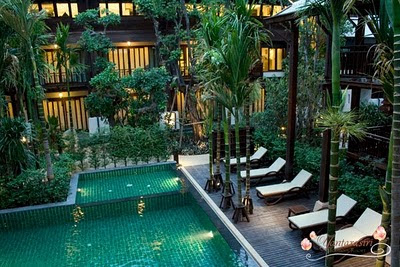 Picture Yantarasiri
Picture Yantarasiri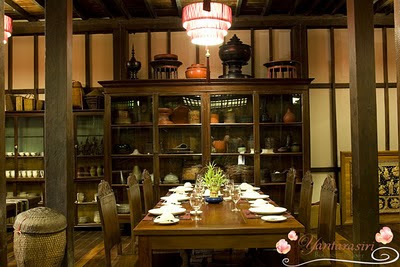 Picture Yantarasiri
Picture Yantarasiri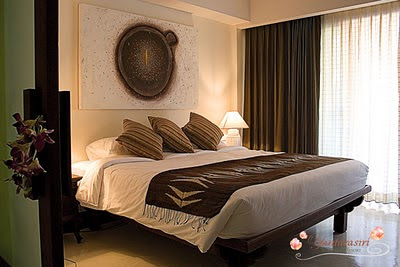 Picture Yantarasiri
Picture YantarasiriZensala Resort: From 4500 Bath. 168 Patan Road. All rooms with floor to ceiling windows with view on Mae Ping River. With Zensala Spa, already known from Bangkok. Swimming pool and library. "Everything is tranquil and relaxing at this small resort, whose idyllic location offers just the right mix of privacy and easy access to the city", writes nationmultimedia.com. Very good reviews on tripadvisor.com for this new resort.
More places to stay in Chiang Mai:
Chiang Mai Guesthouses
Chiang Mai Hotels
Resorts outside of Chiang Mai:
Hotels and Resorts in Mae Rim แม่ริม: Holidays next to the ricefields and in the hills
Discover more:
Your Guide to Chiang Mai
Recommend this blog on Twitter and Facebook:
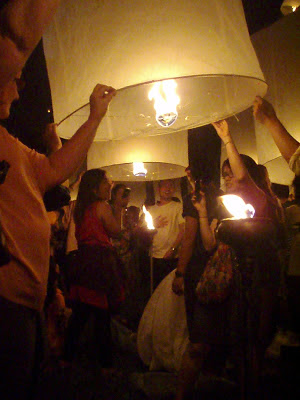







































 Loy Kratong in Mae Jo. Picture
Loy Kratong in Mae Jo. Picture 
 Loy Kratong in Mae Jo. Picture
Loy Kratong in Mae Jo. Picture 































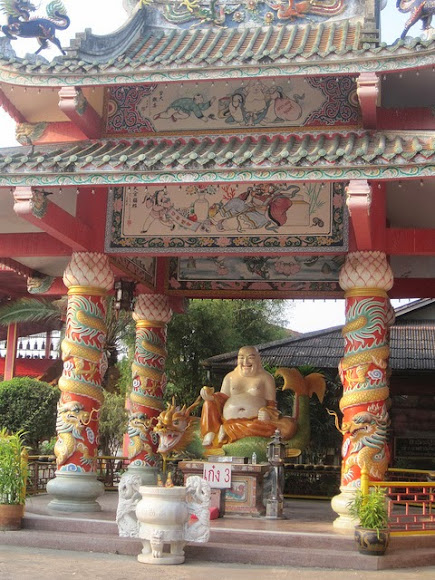


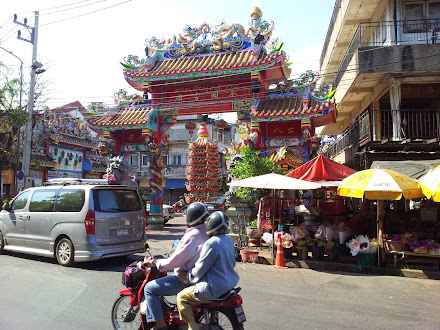
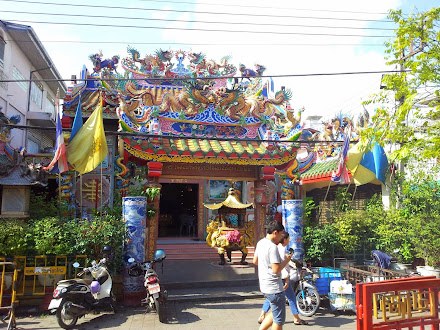
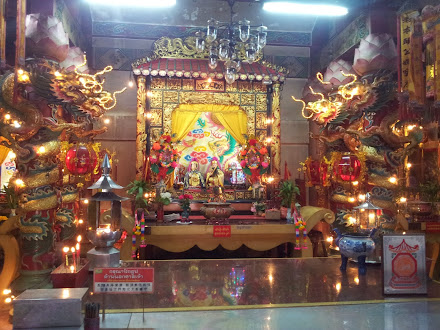




























 Picture marhas
Picture marhas Picture marhas
Picture marhas Picture marhas
Picture marhas Picture marhas
Picture marhas Picture marhas
Picture marhas



































